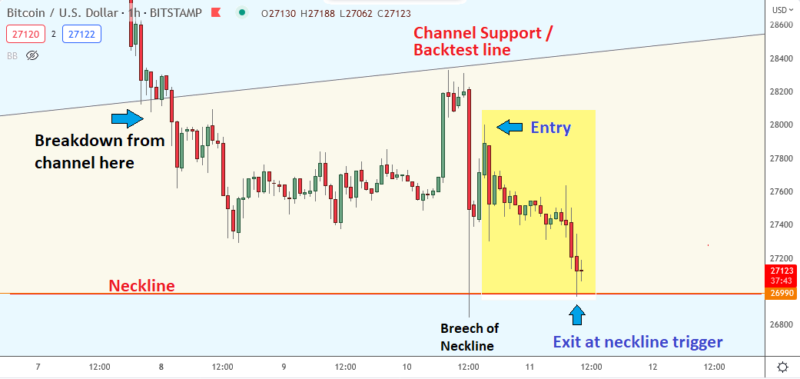Follow Up: Yesterday’s live Bitcoin Trade
Closure. We will have it one way or another. For better or for worse it always comes. Closure with a success is clearly preferred to closure with a loss. And so I can happily report that yesterdays impromtu live Bitcoin trade that I posted at Goldtent has gone very well and ended profitably.
I took an automated exit at the neckline of the chart identified in an earlier post. That means the trade was worth approximately 800 points. Less than I intially estimated but more than is usual for an opportunistic setup. So a quick review is in line for those following this trade. (This post is surely not for the many pros who come to the site and already have their own well-oiled methods of beating the odds but rather for novice traders who may be struggling to make headway in the jungle of technical charts).
There are a few things I want to point out that may be helpful.
The first of course is that technical methods, when properly employed, can certainly yield good results. The second is that longer time frames really do give us ordinary humans a fighting chance in the competitive trade environment. I don’t know about you but my experience is that trading small time frames is a time wasting mugs game and almost always ends in tears eventually. Trading the one minute charts can be exciting of course but you need to understand that is also the prime domain of the algos, bots and computer programs where their lightening fast decision making is designed to scalp you raw at every single turn.
Sometimes we win there, most times we lose. Day traders who try to survive in that miserable one minute environment have about the worst statistical win record of just about anyone alive with fewer than one percent able to make a real living. The other 99 percent end up losing their entire accounts by the time a year has passed. So why even bother? What we need instead is a strategy where humans can still prevail. And that means finding a reliable trend in a soupbowl of jumbled candles and lines.
The third thing I want to point out is the importance of taking a structured, logical approach to trading. This is not gambling. It is math actually and its the strategic employment of well established methods. In my case I utilize Fibbonacci’s, Gartley extensions, Bollinger bands and channel support levels. Under the hood, the basic method relies primarily on mean reversions, Fibbo reversals and standard deviations (not shown in this series). Its all math. Take it seriously and you can indeed do well. These are the same basic recipe ingredients most of the automated programs use. So in order to compete with the machines you will not be on a level playing field unless you clearly understand what they are doing. The main difference between us and them is we target time frames that are longer and where the math whizzes who write the programs do not excel.
So here is my updated chart. My trade was just a small piece of the series of candles you see there. The yellow highlighted region to be specific. I had been following the chart after it broke down from a nice clean bull-channel and wondering where to make an entry. Then along came a 15 minute candle that both backtested the channel support line above and went on to breech the neckline below. That was when opportunity knocked. And that brings me to my fourth point which is to stick with trading volatility. There is just no money to be made trying to trade range-bound sideways markets. Unless you are a machine of course. So don’t even bother because it will just chew you up and destroy your account with commissions and repeated petty losses.
That means waiting for an opportunity to arise. And waiting and waiting and waiting some more sometimes. There is just not a great trade setup every day in spite of what some whizz might try telling you. So patience is helpful and so is knowing how to exercise retraint! Just like dating….. LOL

Congrats on a nice trade!
Many thanks Hermit. It would be great if I had the time to write live trades every day. But once in awhile is still nice.
Plus 1…You GO Farmer
Thanks Fully!
“Its all math.”
Exactly.
So do the math. It is not rocket science math either, although I bet those with physics backgrounds can design the sharper tools.
“I don’t know about you but my experience is that trading small time frames is a time wasting mugs game”
Agree here also. Although I suspect AI wanders into this domain as well.
Yes pedro_deleon, the programs are aimed at all time frames but they primarily target the smallest since that is where the greatest profitability is found. Its not just a single program in the market either. There are thousands upon thousands of routines running all the time and they are written by hundreds of thousands of varied users all over the planet. But in aggregate they still produce some predictable patterns and that is what creates the opportunity for us humans to successfully trade trends.